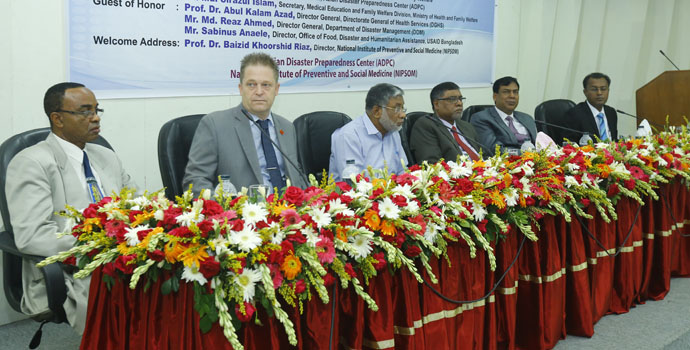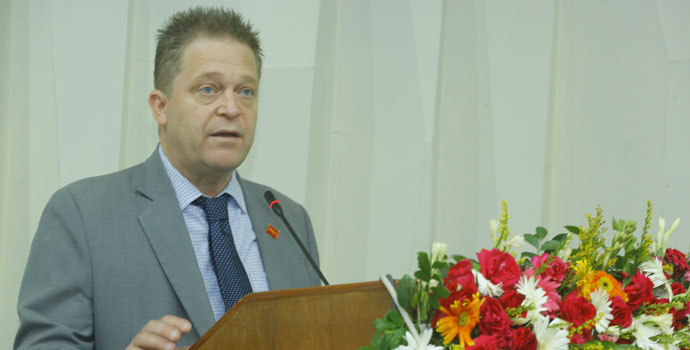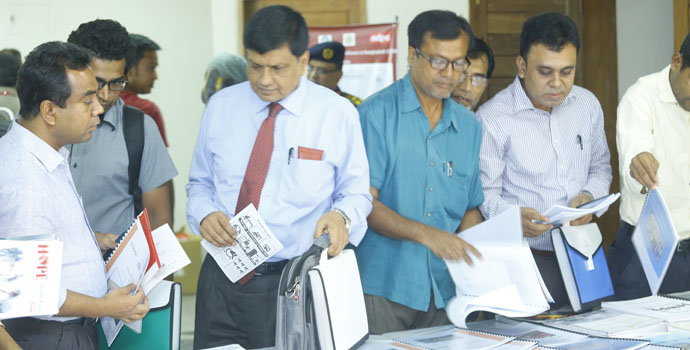- About Us
-
Who we are
-
- Publications
-
- ADPC Academy
-
MediaADPC'S NEWS
ADPC presents Hospital Risk Assessment results during high-level meeting in Bangladesh ADPC presents Hospital Risk Assessment results during high-level meeting in Bangladesh
9 May 2017
Dhaka, Bangladesh

Special guests at the dissemination meeting include (from left) Guest of Honor Mr. Sabinus Anaele, Director, Office of Food, Disaster and Humanitarian Assistance (OFDHA), USAID Bangladesh; Mr. Hans Guttman, Executive Director, ADPC; Mr. Md. Sirazul Islam, Secretary, Medical Education and Family Welfare Divison, Ministry of Health and Family Welfare (MoHFW), Bangladesh; Mr. Zahid Maleque, MP, Honorable State Minister, Ministry of Health and Family Welfare, Bangladesh; Prof. Dr. Abul Kalam Azad, Director General, Directorate General of Health Services (DGHS), Bangladesh; Prof. Dr. Baizid Khoorshid Riaz, Director, National Institute of Preventive and Social Medicine (NIPSOM), Bangladesh.Asian Disaster Preparedness Center (ADPC) shared the results of risk assessments conducted in 16 public hospitals in Dhaka, Chittagong, Sylhet, Mymensigh, Gazipur and Tangail in Bangladesh as part of an ongoing effort to strengthen disaster preparedness in the country.
The assessment enabled hospital management to have a better understanding of risks factors in their facility and utilize the results of the assessment in developing corrective action plans to improve hospital safety from disasters. This also provided a snapshot of the probability that a hospital or health facility will continue to function in emergency situations, based on structural, nonstructural and functional factors identified through the hospitals risk assessment.
The assessments also measured the safety levels of the hospitals and its ability to handle mass casualty incidents. While ratings varied among each hospital, on average all hospitals needs to build its capacity to remain functional during a large scale disaster and handle mass casualty incidents.
The results of the assessment were presented during the Dissemination Meeting on Lessons Identified from Hospital Risk Assessments at the Centre on Integrated Rural Development for Asia and the Pacific (CIRDAP) in Dhaka, Bangladesh. The meeting included officials from the Ministry of Health, Family Welfare, the Directorate General of Health Services, the Department of Disaster Management, hospital and academic institute directors, and officials from UN, INGOs, NGOs, development agencies, diplomatic missions and United States Agency for International Development (USAID) Bangladesh.
Mr. Fredrick John Abo, Program Manager, ADPC, delivered the presentation which included a list of key recommendations to increase operational capacity of the hospitals. These included increasing disaster management interventions in hospitals, building a culture of exercises and learning for hospital staff, protecting key hospital equipment, and increasing protection of hospital lifelines e.g. power, water and communications. Some of these recommendations are as simple and cost effective as tying down an oxygen tank, or other hospital equipment, that could fall over if an earthquake occurredMr. Zahid Maleque, MP Honorable State Minister, Ministry of Health and Family Welfare (MoHFW), Government of the People’s Republic of Bangladesh attended the meeting. He shared that preparedness should be a key focus by initiating training for hospital staff and developing a preparedness, response and recovery plan for earthquake situations. These plans should cover everything from how to clear debris to enable transportation in urban settings, what to do if doctors and nurses are injured in the incident, and how to ensure patients are cared for after a disaster. In terms of infrastructure, existing buildings should be assessed for their risks and new buildings should be constructed to be disaster resilient.
“We should take the necessary actions to fill the gaps and do whatever is required to strengthen our medical system and train our people and prepare for any disasters,” said Mr. Maleque.

Mr. Hans Guttman, Executive Director, ADPC, addressing the audience during the meeting.During the meetings Mr. Hans Guttman, Executive Director, ADPC, talked about the critical role hospitals play during an emergency, and echoed many points of speakers throughout the day, calling for the necessary actions to be taken to improve their resilience to hazards.
“Making hospitals and health facilities safe from disasters is an economic requirement and also a social, moral and ethical necessity,” stated Mr. Guttman. “Special attention must be given to ensure that the physical and functional integrity of hospitals and other health facilities can continue operating in emergency conditions,” he said.
The hospital risk assessment was conducted from 2014 – 2017 as part of the capacity building initiatives under USAID’s Strengthening Earthquake Resilience in Bangladesh (SERB) Program implemented by Asian Disaster Preparedness Center (ADPC). It used the Hospital Safety Index (HSI) Tool of the World Health Organization (WHO) and Pan-American Health Organization (PAHO), a low-cost tool meant to assess the probability that a hospital will remain operational during emergencies and disasters.
Some of the facilities assessed have already started taking action, but there are still improvements needed to increase each of the hospital's safety rating.
Other special guests who spoke at the meeting include Mr. Zahid Maleque, MP, Honorable State Minister, Ministry of Health and Family Welfare, Bangladesh, Prof. Dr. Baizid Khoorshid Riaz, Director, National Institute of Preventive and Social Medicine (NIPSOM); Mr. Sabinus Anaele, Director, Office of Food, Disaster and Humanitarian Assistance (OFDHA), USAID Bangladesh; Prof. Dr. Abul Kalam Azad, Director General, Directorate General of Health Services (DGHS), Bangladesh; and Mr. Md. Sirazul Islam, Secretary, Medical Education and Family Welfare Division, Ministry of Health and Family Welfare (MoHFW), Bangladesh.
Participants collect material outlining the initiatives and achievements of the SERB and HOPE program in Bangladesh.
The SERB program’s focus on capacity building for sustainable resultsOver the past four-year period, USAID’s SERB program has aimed to enhance the capacity of 16 public hospitals in six earthquake-prone Districts in Bangladesh: Dhaka, Chittagong, Sylhet, Mymensingh, Tangail and Gazipur through national training on Hospital Preparedness for Emergencies (HOPE) and Training for Instructors (TFI).
HOPE focuses on improving the capacity of hospitals and healthcare facilities in order for them to be prepared to manage emergencies and mass casualty events. In addition, the Hospital Incident Command System (HICS) course focuses on the operational activities of command groups and the activation of a hospital command center.
The program also provides capacity building for the Fire Service and Civil Defense Authority volunteers providing advanced training and equipping them with tools needed to perform emergency response and rescue, including search tools, rescue equipment, first aid kits, and storage containers.
ADPC has established partnerships with key partner government agencies in the country in the implementation of the SERB Program, namely, the National Institute of Preventive and Social Medicine (NIPSOM) together with the Fire Service and Civil Defense (FSCD), and the Department of Disaster Management (DDM), and the Directorate General of Health Services (DGHS).
Latest NewsRelated Trainings
-